La mostra di Sabrina Sabato si intitola “Contagio”, pone al centro l’idea di un contagio biofisico, metaforico, artistico. Tant’è che il linguaggio pittorico si innesta a quello fotografico, quello fotografico a quello installativo.
Sabrina Sabato è nata a Napoli e dal 1995 vive e lavora a Milano. Ha esposto in gallerie italiane (THE.Napoli; Caterina Fossati, Torino) e straniere (Cordula Von Keller, Colonia). Ha partecipato a varie collettive, tra cui la Quadriennale di Roma del novembre 1996.
Organizzato nell'ambito dell'attività per il Progetto Giovani del Comune di Milano
"Tutte le opere sono progettate appositamente per questa occasione. In mostra troviamo: “Biopsie”, dipinti ottenuti con resine e pigmenti che rappresentano particolari di organismi naturali; “Pittura iperbarica”, una tenda ossigeno, al cui interno l’artista disegnerà in diretta davanti al pubblico, come se volesse proteggersi da virus di qualsiasi natura, ma così facendo pone anche l’accento sul rischio di alienazione che l’eccesso di asetticità comporta; “Camera di ospedale”, una vera stanza costituita con scatole di cartone bianco, al centro campeggia un letto (sempre di cartone) dove è posto un video, realizzato da Sabrina Sabato durante un periodo di degenza in un ospedale milanese. Infine, al centro della stanza, un piccolissimo lettino campeggia su un tappeto che riproduce, deformato, il simbolo della Croce Rossa. La sproporzione dei due “oggetti” disorienta lo spettatore e l’idea stessa della malattia."
Francesca Pasini
Recensione di Francesca Pasini sulla mostra di Sabrina Sabato allo spazio Neon a Bologna (Artforum, marzo 1998).
In ten photographs by Sabrina Sabato arranged along one wall of Galleria Neon, bright colors alternated with more placid hues: red was diluted into tones ranging from pink to ocher; green faded to the bluish transparency of water. Here and there one glimpsed the outline of a leaf or a fragment of a petal, while elsewhere the image was initially unrecognizable. A strange kind of herbarium emerged, in which natural forms were as transparent as X-rays. Enlarged and printed without the intermediary stage of a negative, Sabato’s photographs—unique prints she calls “Sabatographs”—capture leaves, flowers, fruit, and fish in vivid detail. She freezes these natural objects in various stages of growth or decomposition, restoring to them in the process an enigmatic third dimension or liquid state.
On the floor below, an installation entitled Ad occhio chiuso (Blindfolded, 1997) focused on the idea of water. Some thirty-five packing crates were heaped up on top of one another to suggest the contours of a small chain of mountains. Eight cardboard containers were also turned into light-boxes displaying “Sabatographs” of small fish, algae, and herbaceous fibers. Illuminated, they took on the ambiguous presence of a living fiber in the very moment it passes from a liquid to a dense corporeal state. An image continuously flowing water in a canal was projected onto the back wall of the space, on which the shadows of the light-boxes were also superimposed. The rhythmic sound of rushing water combined with the projected images to create an illusion of three-dimensionality. The title of this piece brought to mind the technique Sabato uses to create her photographs, while it also alluded to perception that does not depend on vision.
In all of Sabato’s work, the pictorial result is extremely strong, precisely because the colors suggest a continuous movement that extends beyond the boundaries of the figure. This was particularly evident in the large photographs that were shown at Studio Ercolani, which depicted the petals of a rose, a segment of a yellow flower, and the skin of a fish, the latter resembling a strange watercolor drawing. Here, too, the photographs, which were also framed like paintings, were juxtaposed with a video-tape. Playing on a monitor that rested on the floor, the video showed a closeup of a tropical fish in a vase surrounded by various biology texts, each open to a page with an illustration of a fish. In another room, a “fish out of water” became “water out of a fish.” Instead of the video monitor on the floor, one found an actual vase containing three red fish, surrounded by a small puddle. Once again, this was a figure for the liquid state of living creatures and of nature—the fundamental theme of these two shows.
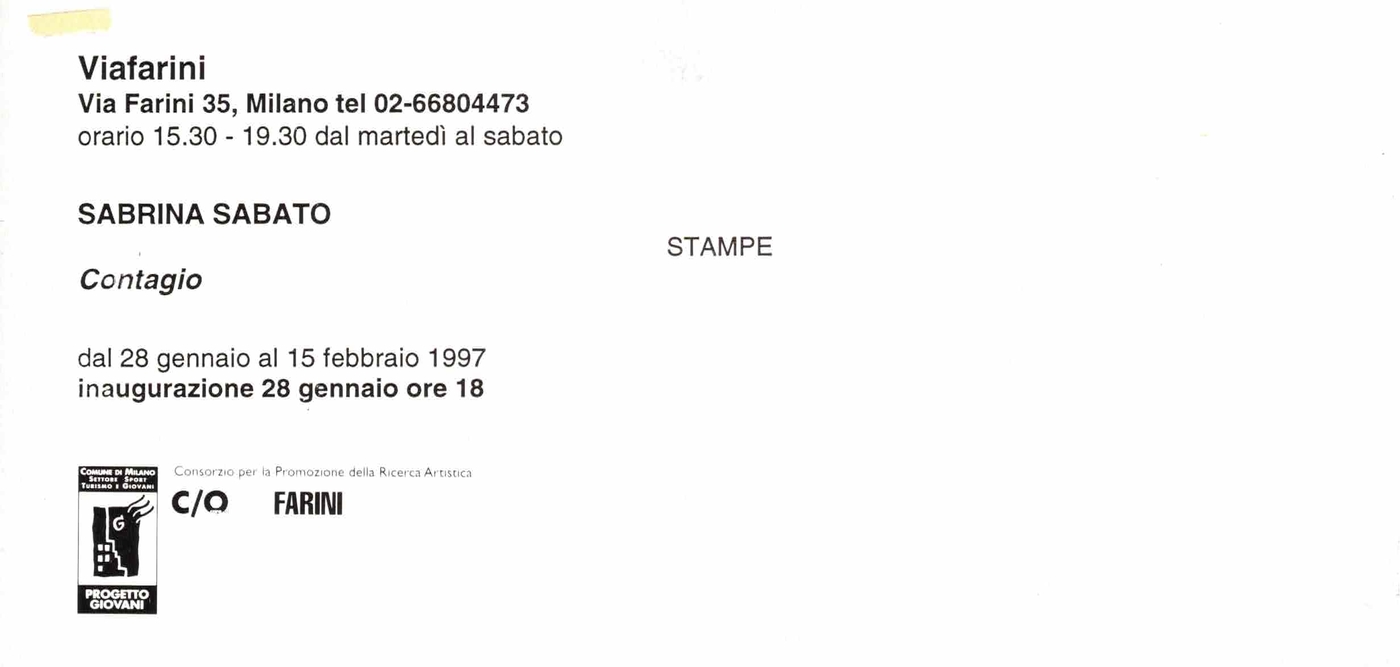
La mostra di Sabrina Sabato si intitola “Contagio”, pone al centro l’idea di un contagio biofisico, metaforico, artistico. Tant’è che il linguaggio pittorico si innesta a quello fotografico, quello fotografico a quello installativo.
Sabrina Sabato è nata a Napoli e dal 1995 vive e lavora a Milano. Ha esposto in gallerie italiane (THE.Napoli; Caterina Fossati, Torino) e straniere (Cordula Von Keller, Colonia). Ha partecipato a varie collettive, tra cui la Quadriennale di Roma del novembre 1996.
Organizzato nell'ambito dell'attività per il Progetto Giovani del Comune di Milano
"Tutte le opere sono progettate appositamente per questa occasione. In mostra troviamo: “Biopsie”, dipinti ottenuti con resine e pigmenti che rappresentano particolari di organismi naturali; “Pittura iperbarica”, una tenda ossigeno, al cui interno l’artista disegnerà in diretta davanti al pubblico, come se volesse proteggersi da virus di qualsiasi natura, ma così facendo pone anche l’accento sul rischio di alienazione che l’eccesso di asetticità comporta; “Camera di ospedale”, una vera stanza costituita con scatole di cartone bianco, al centro campeggia un letto (sempre di cartone) dove è posto un video, realizzato da Sabrina Sabato durante un periodo di degenza in un ospedale milanese. Infine, al centro della stanza, un piccolissimo lettino campeggia su un tappeto che riproduce, deformato, il simbolo della Croce Rossa. La sproporzione dei due “oggetti” disorienta lo spettatore e l’idea stessa della malattia."
Francesca Pasini
Recensione di Francesca Pasini sulla mostra di Sabrina Sabato allo spazio Neon a Bologna (Artforum, marzo 1998).
In ten photographs by Sabrina Sabato arranged along one wall of Galleria Neon, bright colors alternated with more placid hues: red was diluted into tones ranging from pink to ocher; green faded to the bluish transparency of water. Here and there one glimpsed the outline of a leaf or a fragment of a petal, while elsewhere the image was initially unrecognizable. A strange kind of herbarium emerged, in which natural forms were as transparent as X-rays. Enlarged and printed without the intermediary stage of a negative, Sabato’s photographs—unique prints she calls “Sabatographs”—capture leaves, flowers, fruit, and fish in vivid detail. She freezes these natural objects in various stages of growth or decomposition, restoring to them in the process an enigmatic third dimension or liquid state.
On the floor below, an installation entitled Ad occhio chiuso (Blindfolded, 1997) focused on the idea of water. Some thirty-five packing crates were heaped up on top of one another to suggest the contours of a small chain of mountains. Eight cardboard containers were also turned into light-boxes displaying “Sabatographs” of small fish, algae, and herbaceous fibers. Illuminated, they took on the ambiguous presence of a living fiber in the very moment it passes from a liquid to a dense corporeal state. An image continuously flowing water in a canal was projected onto the back wall of the space, on which the shadows of the light-boxes were also superimposed. The rhythmic sound of rushing water combined with the projected images to create an illusion of three-dimensionality. The title of this piece brought to mind the technique Sabato uses to create her photographs, while it also alluded to perception that does not depend on vision.
In all of Sabato’s work, the pictorial result is extremely strong, precisely because the colors suggest a continuous movement that extends beyond the boundaries of the figure. This was particularly evident in the large photographs that were shown at Studio Ercolani, which depicted the petals of a rose, a segment of a yellow flower, and the skin of a fish, the latter resembling a strange watercolor drawing. Here, too, the photographs, which were also framed like paintings, were juxtaposed with a video-tape. Playing on a monitor that rested on the floor, the video showed a closeup of a tropical fish in a vase surrounded by various biology texts, each open to a page with an illustration of a fish. In another room, a “fish out of water” became “water out of a fish.” Instead of the video monitor on the floor, one found an actual vase containing three red fish, surrounded by a small puddle. Once again, this was a figure for the liquid state of living creatures and of nature—the fundamental theme of these two shows.
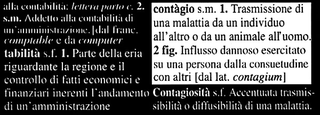
L'invito
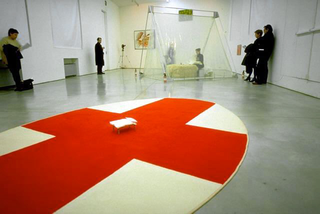
Veduta dell'allestimento
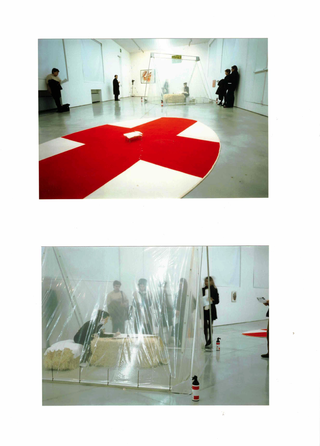
Senza Titolo, lettino e tappeto
Pittura Iperbarica, tende, ossigeno, paglia
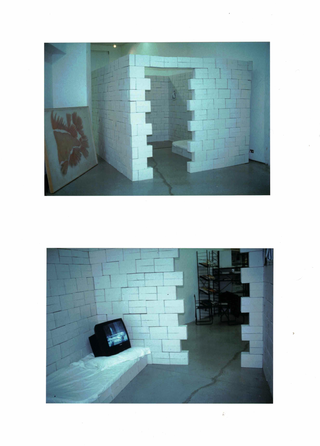
Camera
scatole di cartone, video.
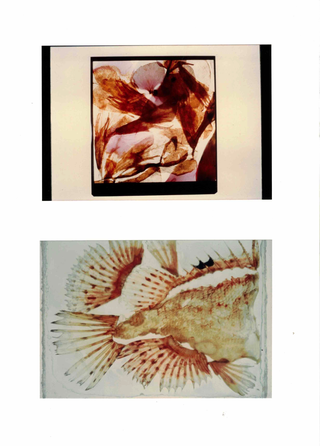
Autopsie
sabatofotografie in cibachrome
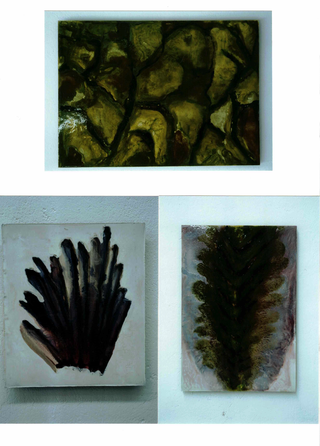
Biopsie
resine e pigmenti.
Social
Contatti
viafarini@viafarini.org